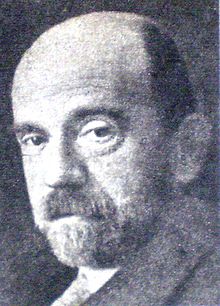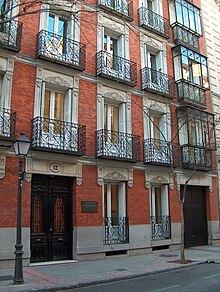Pio Baroja
Pío Baroja y Nessi (born December 28, 1872 in San Sebastián , † October 30, 1956 in Madrid ) was a Spanish writer and a representative of the Generación del 98 .
Life
Pío Baroja y Nessi was the son of the mining engineer Serafin Baroja (1840-1912), who was of Basque origin, and Carmen Nessi y Goñi (1849-1935), who came from Lombardy . In this "mixture of origins" Baroja often seeks the reason for his inner conflict. At that time his father worked for several newspapers, he wrote poems and essays in Spanish as well as in Basque language . His father influenced his son's literary interests, but Baroja rarely talked about his father. The relationship with the mother was closer, stronger. Frequent moving because of the father's job became more and more important after 1880. Being torn out of a known circle and being placed in a new one now determined his life and denied him any chance for true, long friendships. His sister Carmen Baroja (1883–1950) and his brother Ricardo Baroja (1871–1953) were also active in the arts and writing.
Pío Baroja y Nessi spent most of his life in Madrid. At the Instituto San Isidro in Madrid, Pío achieved his “bachillerato” at the age of 15. In 1887 he began to study medicine in Madrid . He attended the pathology courses of José de Letamendi y Manjarrés (1828-1897) in the fourth year of his studies , which reinforced his critical stance on the state of knowledge of medicine. But he secretly hoped to quench his thirst for knowledge and truth in the university. The study of medicine did not bring the desired success, twice he failed the intermediate examination at the Facultad de San Carlos in Madrid.
Baroja moved to Valencia , where his father was transferred. Embittered, he immersed himself in his studies and obtained the final exam at the University of Valencia in 1893 . With a "psychophysical" study on pain he obtained his doctorate , which was, however, supported more by theories than experimental foundations and generally gave Barojas a pessimistic view of life similar to Schopenhauer . What was particularly significant in his study was that life in its normal state does not trigger pleasure or pain, but a feeling of indifference.
After graduating, Baroja worked as a medical officer ( médico de pueblo ) in the small town of Cestona in the province of Gipuzkoa in the Basque Country from 1894 . It was at that time that he wrote his first stories , with which he tried to make the country and people of the Basque homeland known to a broad masses. His stay there was short, he accompanied his father and after being permanently unemployed, he tried his hand at an inherited bakery in Madrid together with brother Ricardo, which only succeeded after some time.
Pío Baroja y Nessi was one of the famous members of the " Generación del 1898 ", a name that went back to José Martínez Ruiz . The consequences of the Spanish-American War , which was often experienced as a national shock, led to a tense social and political situation in the Kingdom of Spain. The Generación del 1898 occurred at this time for a political reconsideration of the country, coupled with a rejection of the recent past and the ideas of traditional art, ideals, morality and politics. The collection of novels "Vidas Sombrías" was published for the first time in 1900, albeit with little success. Here keen powers of observation were combined with fine emotional sensitivity . A little later, he and José Martínez Ruiz (with stage name "Azorín") were introduced to each other; A group of young intellectuals gathered around the two of them who wanted to break away from the previous schematic image of Spain. There the Swiss Paul Schmitz found himself again, who largely introduced Baroja to Nietzsche's ideas and ways of thinking , which from then on shaped him alongside Schopenhauer.
In the next few years he founded various magazines or worked on them, such as B. "El Globo" or "Juventud", which reflected national rebirth, democratic structures, socialism and doctrines of political anarchism. It was not until 1902 that Baroja achieved his literary breakthrough with the novel "Camino de Perfección", which was representative of the struggle of his generation. Pío was a passionate traveler who incorporated the impressions he had gained into many of his novels. He was also impressed by Germany, whose intellectual life he saw as a leader in the European community. Politically, he did not like to emerge, it seemed too dirty business to him, and yet he was an obvious opponent of the Primo de Rivera dictatorship .
In Pío Baroja's adventure novels the longing for the heroic that lives in us all finds strong expression. His work reflects the problems of the Spanish people who have been wrestling with the new shape of Spain since 1898. A typical Bildungsroman is the novel El árbol de la ciencia (1911) with a pessimistic attitude and strongly autobiographical statements represented by the fictional character of "Andrés Hurtados". Helmut Demuth writes that Baroja is actually always about himself and divides his books into two groups: “unos, los he escrito con más trabajo que gusto; otros, los he escrito con más gusto que trabajo ”( some he wrote with more work than pleasure, others he wrote with more pleasure than work ).
Like many intellectuals and authors of his time, he lived in France during the Spanish Civil War .
He was a member of the Real Academia Española (Sillón a) from 1935 to 1956 .
On October 30, 1956, at the age of 83, Pío Baroja y Nessi died in Madrid. His sister Carmen had died in 1949 and his brother Ricardo in 1953.
Works (selection)
- La casa de Aizgorri. 1900.
- El mayorazgo de Labraz. 1903.
- Zalacaín el aventurero. 1908. (German edition Zalacain the Adventurer. Paul List, Leipzig 1943)
- La leyenda de Jaun de Alzate. 1922.
- La busca. 1904.
- Mala hierba. 1904.
- Aurora roja. 1904.
- El arbol de la ciencia. 1911. (German edition The Tree of Knowledge. Herder, Freiburg 1991, ISBN 3-451-22485-2 )
- La dama errante. 1908.
- La ciudad de la niebla. 1909.
- Aventuras, inventos y mixtificaciones de Silvestre Paradox. 1901.
- Camino de perfección. (pasión mística) 1901.
- Paradox rey. 1906.
- César o nada. 1910.
- El mundo es ansí. 1912.
- La sensualidad pervertida: ensayos amorosos de un hombre ingenuo en una época de decadencia. 1920.
- Las inquietudes de Shanti Andía. 1911.
- El laberinto de las sirenas. 1923.
- Los pilotos de altura. 1929.
- La estrella del capitán Chimista. 1930.
- El gran torbellino del mundo. 1926.
- Las veleidades de la fortuna. 1927.
- Los amores tardíos. 1942.
- La familia de Errotacho. 1932.
- El cabo de las tormentas. 1932.
- Los visionarios. 1932.
- Las noches del Buen Retiro. 1934.
- Locuras de carnaval. 1937.
- El cura de Monleón. 1936.
literature
- Joxe Azurmendi : Pio Baroja: esencia española, cultura vasca. In: Espainiaren arimaz. Elkar, Donostia 2007, ISBN 978-84-9783-402-5 .
- Dwight Bolinger : The philosophy of Pío Baroja with special reference to the influence of Nietzsche . University of Kansas, Romance Language and Literature, Lawrence 1932, OCLC 53861825 .
- Dwight Bolinger: Pío Baroja: a critique. University of Wisconsin, Madison 1936.
- Ignacio Elizalde: Baroja y su ideologíca filosófica. Pp. 49-56.
- Sandra Obermeier: Poeta medicus. The literary writing of writers-doctors using the example of Pío Baroja, Louis-Ferdinand Céline and Luis Martín-Santos. Thesis. Grin Verlag, Munich 2010, ISBN 978-3-656-72990-7 .
- Sofia Sogos: El árbol de la ciencia e la leyenda de Jaun de Alzate: L'espressione del pessimismo in Pío Baroja. Edited by Giorgia Sogos. Free Pen Verlag, Bonn 2017, ISBN 978-3-945177-52-5 .
Web links
- Literature by and about Pío Baroja in the catalog of the Ibero-American Institute in Berlin
- Literature by and about Pío Baroja in the catalog of the German National Library
- Literature by and about Pío Baroja in the catalog of the library of the Instituto Cervantes in Germany
Individual evidence
- ↑ Web portal about Pío Baroja
- ^ FB Piñero: Letamendi y Manjarres, José de. MCNbiografias
- ^ José Carlos Mainer: Pío Baroja. Taurus, Madrid 2012, ISBN 978-84-306-0908-6 .
- ↑ Biography of Pío Baroja. (Diccionario Enciclopédico Vasco Auñamendi)
- ↑ Sandra Obermeier: From scalpel to pen: When doctors become writers. Diplomica Verlag, Hamburg 2014, ISBN 978-3-95850-645-9 , p. 9 f.
- ↑ Helmut Demuth: Pio Baroja, the world view in his works. Inaugural dissertation . Rheinische Friedrich-Wilhelms-Universität Bonn, Hagen 1937.
| personal data | |
|---|---|
| SURNAME | Baroja, Pio |
| ALTERNATIVE NAMES | Pío Baroja y Nessi |
| BRIEF DESCRIPTION | Spanish writer |
| DATE OF BIRTH | December 28, 1872 |
| PLACE OF BIRTH | San Sebastian |
| DATE OF DEATH | October 30, 1956 |
| Place of death | Madrid |




